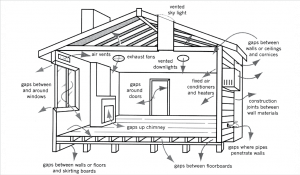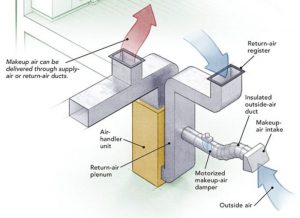2 HRV/ERV
 In the past, we use to relied on infiltration and exfiltration for fresh air to be introduced into a building. Air would passively flow through a building depending on surrounding pressures. Then, turning on a bathroom fan or kitchen exhaust to create a negative pressure within a building, causing fresh outside air to be drawn in was acceptable. But with stricter regulations and guidelines on energy consumption, we have changed the way we construct our homes. We no longer allow air to pass through buildings, that is to say we no longer allow natural ventilation to occur. So we must ventilate mechanically with fans.
In the past, we use to relied on infiltration and exfiltration for fresh air to be introduced into a building. Air would passively flow through a building depending on surrounding pressures. Then, turning on a bathroom fan or kitchen exhaust to create a negative pressure within a building, causing fresh outside air to be drawn in was acceptable. But with stricter regulations and guidelines on energy consumption, we have changed the way we construct our homes. We no longer allow air to pass through buildings, that is to say we no longer allow natural ventilation to occur. So we must ventilate mechanically with fans.
Part of the fresh air requirements are introduced into the return duct. A small line, from outside, is tee’d into the return duct allowing outside air directly into the return air stream. This is a good way to introduce fresh air, but has some drawbacks. It is inefficient. Adding unconditioned air into the system means that the air must be fully conditioned before entering the home. The air that leaves in its place was already fully conditioned so this requires more energy consumption. The other problem is what happens to the air displaced by this process? If we introduce more air, the pressure increases in the building. If there is not the ability through for the air to escape, the building will have issues, such as doors swinging open and being difficult to close.
Today, it is more common to see equipment like  HRV’s (Heat Recovery Ventilator) and ERV’s (Energy Recovery Ventilator) used to accomplish the ventilation requirements of a home. These units contain a heat exchanger and work on the theory of heat transfer. In there simplest form, they have 2 airstreams, in and out or supply and exhaust, and a heat exchanger. As the 2 airstreams pass each other, heat energy is transferred from one to the other, thus saving energy consumption. The 2 airstreams never actually come into contact with each other, but pass through the heat exchanger together. In the heating months, the warm indoor air passes by the cool outdoor air before it is expelled. The indoor air gives up some of its heat, warming the outdoor air before it enters the space. The difference between an HRV and an ERV is that an ERV also works with humidity. It can control the amount of moisture within a home.
HRV’s (Heat Recovery Ventilator) and ERV’s (Energy Recovery Ventilator) used to accomplish the ventilation requirements of a home. These units contain a heat exchanger and work on the theory of heat transfer. In there simplest form, they have 2 airstreams, in and out or supply and exhaust, and a heat exchanger. As the 2 airstreams pass each other, heat energy is transferred from one to the other, thus saving energy consumption. The 2 airstreams never actually come into contact with each other, but pass through the heat exchanger together. In the heating months, the warm indoor air passes by the cool outdoor air before it is expelled. The indoor air gives up some of its heat, warming the outdoor air before it enters the space. The difference between an HRV and an ERV is that an ERV also works with humidity. It can control the amount of moisture within a home.
